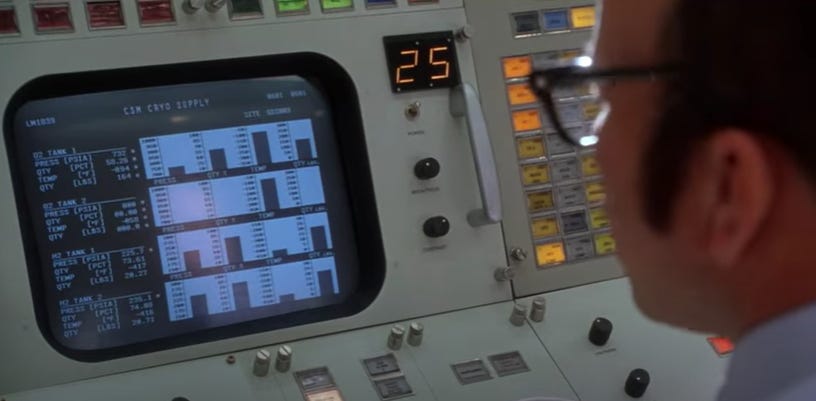In this week’s ‘Mark My Words’, founder Mark Borkowski explains why PR jargon is bad for everyone.
I love technobabble in space movies. One of my favourite scenes from Apollo 13 is when Tom Hanks recreates the infamous, ‘Houston, we have a problem’ moment, which I remember hearing on the radio as a child. What follows is a barrage of technical language and spaceship jargon that only an engineer at Space X could fully understand. It gives an air of authenticity to the scene—the writers had only to take the transcript from the original Apollo 13 mission to come up with, ‘Houston, we’ve had a MAIN B BUS UNDERVOLT… I’m going to try a PGNCS reset… Roger, and we’re looking at our SERVICE MODULE RCS HELIUM 1—B is Barber poled and D is barber poled, CAN I GET A BMAG TEMPERATURE?!’
In addition to giving the film an authenticity borrowed from scientific language, the stream of technical speech also adds to the chaos and confusion of the scene. It induces the same panic in the viewer that the astronauts feel when they hear a loud ‘bang’ in their spaceship. The scene is shot with jerky camera movements, an array of red warning lights blinking, and alarms sounding. The technobabble enhances the panic we start to feel when confronted with the failure of high-tech systems.
It is the same when, in the sci-fi film ‘Arrival’—another favourite—an American linguist is going up into a spaceship to meet some outer space aliens. We are made to identify with this student of how people actually speak when one of her NASA colleagues calls back to headquarters to report, ‘gravity nominal in the antechamber’. I love that detail. Gravity nominal in the antechamber. It’s so perfect: of all the things you could say when confronted with giant floating tentacular outer space beings, of course this professional astronaut summons the safest of scientific jargons. This technobabble makes it all the more effective when the linguist meets the aliens, and, not yet initiated into the finer points of NASAspeak, she utters some technical language of her own: ‘Holy fuck’.
Technobabble has a long history in movies. As Wikipedia has it, ‘various fields of industry have their own specialized vocabularies, or jargon, that allow those educated within that industry to concisely convey ideas that may be confusing, misleading, or nonsensical to an outside listener.’ PR is no different than space travel in having its own special jargon. Just this week, in an article about how PR can survive the pandemic, I encountered a text riddled with PRspeak about ‘improving cut-through’ and having ‘social media events supporting the ecosystem of virtual and non-physical event activity’. Paired together, these approaches can generate ‘strong thrust creating desire for ROI echo chamber.’
The thing is, in movies, technobabble is famously used to paper over plot-holes and faulty science. It is a blunt weapon which invokes ‘suspension of disbelief’ by numbing the viewer. Technobabble is a sedative for the audience, stringing together a series of elements which makes us believe in the quasi-scientific solutions, in series like Star Trek, to dramatic problems. It’s the sci-fi trope that ‘Back to the Future’ brilliantly riffed on with its ‘Flux Capacitor’. But if, as Wikipedia says, sci-fi writers use jargon to ‘give an impression that they know things that their readers or listeners do not’, what is its purpose in PR circles? Who are we trying to deceive? Is ‘promoting vertical click-through’ just another turboencabulator? Who is it meant to trick?
I worry that our dependence on scientific jargon reflects a crisis of confidence in our own value. Despite what the sound bites strewn with termes d’art would have you believe, PR still comes down to a few basics. We are mistaken if we think our clients want to hear about enhancing digital touchpointing in a competitive space to add SEO backlicking value. What do we really do? We listen to clients. We call journalists. We help craft a way for brands to present themselves to the world. It is, literally, not rocket science, though, done with a human eye and ear for detail, it can propel clients to the moon and back—and help them navigate some Apollo 13 moments of their own.
If we start speaking sense again, we will cut through the pretensions of the PR hucksters who use language to cast a veil over the day-to-day workings of their trade, and help our clients to see what it is we can actually do for them. It is not magic—the proof is there. But we must let the sedative of technobabble take away from the true value of our work. Especially now, to ensure the smooth passage of our industry through the space-time continuum of COVID, we need to start talking like real people again.
For more of our work, go to our website.



